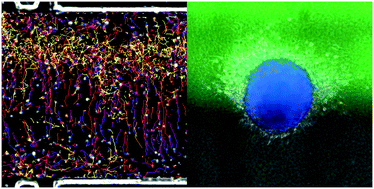Our official English website, www.x-mol.net, welcomes your feedback! (Note: you will need to create a separate account there.)
A tuneable microfluidic system for long duration chemotaxis experiments in a 3D collagen matrix
Lab on a Chip ( IF 6.1 ) Pub Date : 2017-10-06 00:00:00 , DOI: 10.1039/c7lc00649g Koceila Aizel 1, 2, 3, 4, 5 , Andrew G. Clark 5, 6, 7, 8, 9 , Anthony Simon 5, 6, 7, 8, 9 , Sara Geraldo 5, 6, 7, 8, 9 , Anette Funfak 1, 2, 3, 4, 5 , Pablo Vargas 5, 6, 7, 8, 9 , Jérôme Bibette 1, 2, 3, 4, 5 , Danijela Matic Vignjevic 5, 6, 7, 8, 9 , Nicolas Bremond 1, 2, 3, 4, 5
Lab on a Chip ( IF 6.1 ) Pub Date : 2017-10-06 00:00:00 , DOI: 10.1039/c7lc00649g Koceila Aizel 1, 2, 3, 4, 5 , Andrew G. Clark 5, 6, 7, 8, 9 , Anthony Simon 5, 6, 7, 8, 9 , Sara Geraldo 5, 6, 7, 8, 9 , Anette Funfak 1, 2, 3, 4, 5 , Pablo Vargas 5, 6, 7, 8, 9 , Jérôme Bibette 1, 2, 3, 4, 5 , Danijela Matic Vignjevic 5, 6, 7, 8, 9 , Nicolas Bremond 1, 2, 3, 4, 5
Affiliation

|
In many cell types, migration can be oriented towards a chemical stimulus. In mammals, for example, embryonic cells migrate to follow developmental cues, immune cells migrate toward sites of inflammation, and cancer cells migrate away from the primary tumour and toward blood vessels during metastasis. Understanding how cells migrate in 3D environments in response to chemical cues is thus crucial to understanding directed migration in normal and disease states. To date, chemotaxis in mammalian cells has been primarily studied using 2D migration models. However, it is becoming increasingly clear that the mechanisms by which cells migrate in 2D and 3D environments dramatically differ, and cells in their native environments are confronted with a complex chemical milieu. To address these issues, we developed a microfluidic device to monitor the behaviour of cells embedded in a 3D collagen matrix in the presence of complex concentration fields of chemoattractants. This tuneable microsystem enables the generation of (1) homogeneous, stationary gradients set by a purely diffusive mechanism, or (2) spatially evolving, stationary gradients, set by a convection–diffusion mechanism. The device allows for stable gradients over several days and is large enough to study the behaviour of large cell aggregates. We observe that primary mature dendritic cells respond uniformly to homogeneous diffusion gradients, while cell behaviour is highly position-dependent in spatially variable convection–diffusion gradients. In addition, we demonstrate a directed response of cancer cells migrating away from tumour-like aggregates in the presence of soluble chemokine gradients. Together, this microfluidic device is a powerful system to observe the response of different cells and aggregates to tuneable chemical gradients.
中文翻译:

可调谐的微流体系统,用于在3D胶原蛋白基质中进行长时间的趋化性实验
在许多细胞类型中,迁移可以针对化学刺激。例如,在哺乳动物中,胚胎细胞迁移以跟随发育线索,免疫细胞向炎症部位迁移,癌细胞在转移过程中从原发肿瘤向血管迁移。因此,了解细胞如何响应化学线索在3D环境中迁移对于理解正常状态和疾病状态下的定向迁移至关重要。迄今为止,已经主要使用2D迁移模型研究了哺乳动物细胞的趋化性。但是,越来越清楚的是,细胞在2D和3D环境中迁移的机制差异很大,并且其本机环境中的细胞面临着复杂的化学环境。为了解决这些问题,我们开发了一种微流控设备,可在复杂的趋化剂浓度场存在的情况下监控嵌入3D胶原蛋白基质中的细胞的行为。这种可调谐的微系统能够生成(1)由纯扩散机制设置的均匀平稳梯度,或(2)由对流扩散机制设置的空间演化的静态梯度。该设备可以在几天内保持稳定的梯度,并且足够大以研究大型细胞聚集体的行为。我们观察到,原代成熟的树突状细胞对均质扩散梯度具有统一的响应,而细胞行为在空间可变的对流-扩散梯度中高度依赖位置。此外,我们证明了在可溶性趋化因子梯度存在下癌细胞从肿瘤样聚集体迁移的定向反应。总之,这种微流控设备是一个功能强大的系统,可观察不同细胞和聚集体对可调节化学梯度的响应。
更新日期:2017-11-07
中文翻译:

可调谐的微流体系统,用于在3D胶原蛋白基质中进行长时间的趋化性实验
在许多细胞类型中,迁移可以针对化学刺激。例如,在哺乳动物中,胚胎细胞迁移以跟随发育线索,免疫细胞向炎症部位迁移,癌细胞在转移过程中从原发肿瘤向血管迁移。因此,了解细胞如何响应化学线索在3D环境中迁移对于理解正常状态和疾病状态下的定向迁移至关重要。迄今为止,已经主要使用2D迁移模型研究了哺乳动物细胞的趋化性。但是,越来越清楚的是,细胞在2D和3D环境中迁移的机制差异很大,并且其本机环境中的细胞面临着复杂的化学环境。为了解决这些问题,我们开发了一种微流控设备,可在复杂的趋化剂浓度场存在的情况下监控嵌入3D胶原蛋白基质中的细胞的行为。这种可调谐的微系统能够生成(1)由纯扩散机制设置的均匀平稳梯度,或(2)由对流扩散机制设置的空间演化的静态梯度。该设备可以在几天内保持稳定的梯度,并且足够大以研究大型细胞聚集体的行为。我们观察到,原代成熟的树突状细胞对均质扩散梯度具有统一的响应,而细胞行为在空间可变的对流-扩散梯度中高度依赖位置。此外,我们证明了在可溶性趋化因子梯度存在下癌细胞从肿瘤样聚集体迁移的定向反应。总之,这种微流控设备是一个功能强大的系统,可观察不同细胞和聚集体对可调节化学梯度的响应。


























 京公网安备 11010802027423号
京公网安备 11010802027423号